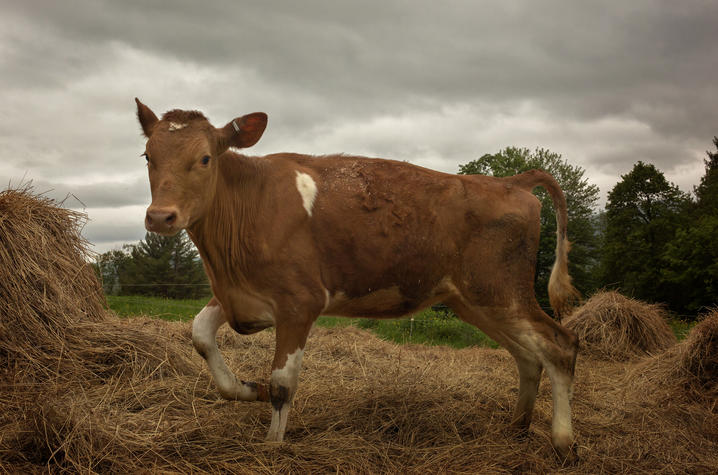UK Photography Lecturer's Exhibition Examines Dairy Farmers' Struggle

LEXINGTON, Ky. (Nov. 10, 2020) — Only a few days remain to check out Institute 193's exhibit of work by James R. Southard, senior lecturer of photography at the University of Kentucky School of Art and Visual Studies. His show called “Why Buy the Cow” will be up until Nov. 14.
For the past few years, Southard has spent his summers in Johnson, Vermont, documenting the daily life of small-scale dairy farmers. The photographs in this exhibition focus on the Rankin family and tell a familiar story about the collapse of the dairy industry in the region: large, automated, and heavily mechanized operations systematically undercut local farms, leading to the closure of the majority of artisanal operations and increased suicide rates amongst the farmers.
“Institute 193 chose to exhibit Southard’s photographs not only because they are exceptional works of art on their own, but because they also draw attention to the struggles locally owned farms grapple with on a daily basis to stay afloat in an ever-evolving, mechanized world," said gallery spokeswoman Liz Glass.
When asked how he arrived at this topic, Southard explained, “I had heard about the rise in suicide rates in the dairy industry, up in the northeast, due to the falling dairy prices. Small scale family farms that have been around for generations are shutting down, and I was curious to meet some of these farmers before they disappeared. One farm family stood out and they allowed me to document their farm. They only asked I show what their way of life is like before it disappears.”
Southard's photographic style walks a fine line between documentary and staged photography. Both rooted in longstanding tradition, each discipline utilizes a different approach to storytelling: in a staged photograph, the photographer intentionally sets the scene to tell a preconceived narrative, whereas documentary photography often relies on capturing an unaltered moment in time.
Most of Southard’s photography concerns agricultural communities in rural Kentucky, Wyoming, Maine and Vermont. This year the COVID-19 pandemic presented challenges for him when it came to research and travel.
“During COVID times, I have had to adapt my research. Normally I travel abroad and shoot most of my work for the year during summer break. Now that has been canceled as most travel is impossible. Instead of starting a project I was to do with farmers and fisherman of Maine, I began a new photo series with farmers from each county in Kentucky. I have only hit 12 counties so far, but I know it is a series I’ll be continuing for years,” Southard said. To see work from this current project, visit: www.jamesrsouthard.com/ky.php.
Many galleries and museums have learned to adapt to COVID-19 protocols as well. Southard explains that it is important for people to get out, see artwork and take advantage of online series and lectures that you can attend no matter where you live.
“I understand that the pandemic has shut down many museums and galleries, but they have adapted and allowed people to book private tours or limit how many visitors can attend an exhibition. During COVID, you have a much more intimate experience with artwork as it is only you and the art,” he said.
Southard’s project in Vermont was made possible by help from the Great Meadows Foundation, Vermont Studio Center, UK School of Art and Visual Studies and The Food Connection @ UK.
Proceeds from this exhibition will be equally shared and donated to the Northeast Organic Farming Association of Vermont.
A Kentucky native, Southard received his bachelor's degree from University of Louisville in 2005, then went on to work as a freelance photojournalist and artist. He received his Master of Fine Arts from Carnegie Mellon University in 2011. Southard has taught at University of Louisville, Kentucky School of Art and Carnegie Mellon University. In 2012, he continued his series “Tooth and Nail” with the collaboration of the city of Seoul, Korea, at Seoul Art Space Geumcheon. He has since returned to academia by teaching photography at UK.
Institute 193 collaborates with artists, musicians and writers to document the cultural landscape of the modern South.
The UK School of Art and Visual Studies, part of the College of Fine Arts, offers undergraduate and graduate degrees in the fields of art studio, art history and visual studies, art education, curatorial studies and digital media design.
As the state’s flagship, land-grant institution, the University of Kentucky exists to advance the Commonwealth. We do that by preparing the next generation of leaders — placing students at the heart of everything we do — and transforming the lives of Kentuckians through education, research and creative work, service and health care. We pride ourselves on being a catalyst for breakthroughs and a force for healing, a place where ingenuity unfolds. It's all made possible by our people — visionaries, disruptors and pioneers — who make up 200 academic programs, a $476.5 million research and development enterprise and a world-class medical center, all on one campus.




